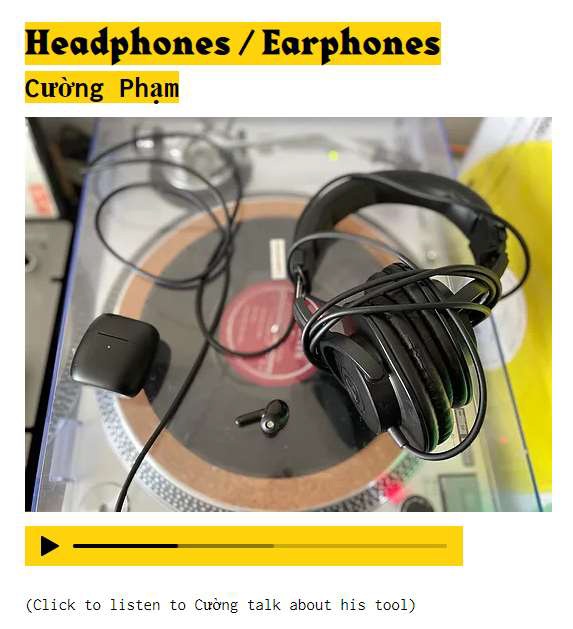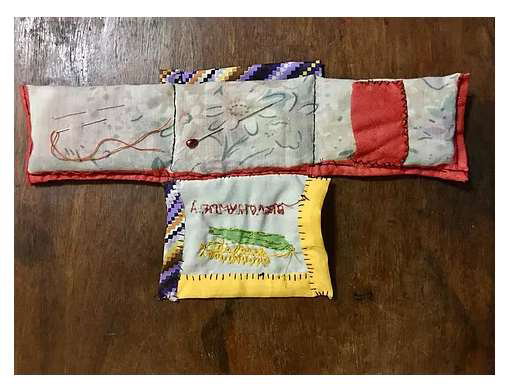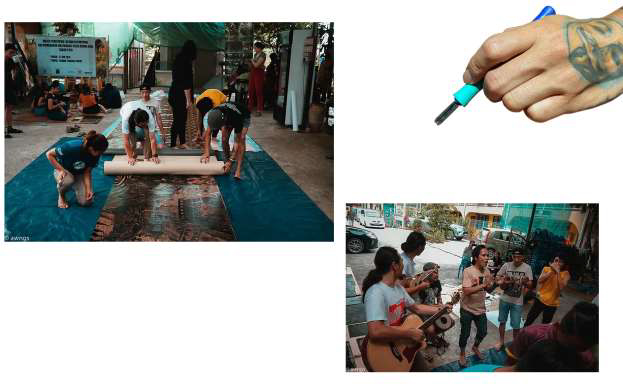If you’re reading this article from your workstation, take a good look at your surroundings. Now, take a look at an object featured in Tools of The Trade. Did you see something you’d find in your own workspace?
Tools of the Trade is a virtual collection of objects exhibited on a website that can be easily viewed on any device with an internet browser. It does away with the complexities that 3D rendered mock gallery spaces create —like take up bandwidth on a literal and figurative sense— instead it gives way to more productive things, like letting visitors actually experience the show.
Whether this was intentional or not, the simple web design values the user’s experience. This approach does not burden the viewers with a desire to experience the exhibition in person. Instead, visitors are regarded as readers of this blog-like show-and-tell by way of a virtual exhibition space.
As the title suggests, Tools of the Trade demystifies power relations by drawing similarities found in cultural labor and the tools they use. Each tool gets its own page and are seen as backdrop-less images on the exhibit’s home page. Additional photos and texts or audio narrated in a conversational tone provide meaning to each of them, creating an experience as opposed to letting visitors browse through one image and on to the next.
Kiat Kiat Projects’ curators Arianna Mercado and Yuji de Torres are no strangers to atypical exhibition spaces — from holding exhibits in a house inside a gated village, a pizza parlor, and even through an e-newsletter. Tools of the Trade is another example of the collective’s willingness to work with the limitations, or rather, possibilities offered on a virtual space.
The exhibition brings our attention to six cultural workers with varied culture-building professions. It spans from art production, publishing, and organizational efforts involving grassroot communities. We are offered a glimpse at how cultural laborers navigate invisible contradictions in their work that are shaped by socio-political layers —some of which could figure as a crutch in their field of work.
A Survey of Cultural Work
As of June 10, 2020, an estimated total of Php 268,661,175 of lost income from the creative industry alone was reported on ilostmygig.ph. Among the affected in that industry are cultural workers.1 Financial support from the government for this sector during the pandemic comes as a drop in the ocean. Now, cultural workers more likely turn to financial grants provided by foreign cultural institutions to continue their projects.
While the exhibition does not necessary bring up these pains, the curators anchor the exhibition on identity politics that have long existed even before the pandemic. Particularly by surveying workers on how they use tools to further cultural work in service of causes that they believe in.
The project taps a modest sample size of participants however, it is enough for the type of attention afforded on a website —they keep things short and sweet. The participants were invited to select objects they often used in their practice and briefly discuss how it serves them.
Kiat Kiat projects considers the agenda of the comprador bourgeoisie, it’s usually about building soft power through cultural work, a very specific anxiety to tackle but has many layers that one doesn’t even know where to begin.
In order to articulate these tensions and layers, the individual contexts of these cultural workers let the viewer find these tensions that challenge the work they push forward for the benefit of the communities they operate within.
Talking about how they use their tools, like what returns they get for having invested or being gifted with them, and even how these serve as a mean towards achieving a desired output, the dynamics between cultural agents with power and its laborers does not surface as a contrite effort.
These points of discussion are similar prompts that can help break down relationships between identities shadowed by their semi-colonial and / or semi-feudal contexts and their overlords, cleverly switching the narrative between the two.
Tools for Building Soft Power
Among the tools we see in the exhibit include a software program that provides work convenience such as the case of the Indonesian editor Harry Isra Muhammad's "Crossword Dictionary". We see through this example how a program designed for building Crossword puzzles, a recreational medium, is instead used for the benefit of drawing up interesting titles as demanded by Muhammad’s editorial work.
For the independent Filipina publisher Gantala Press, they chose a couple of key visuals found in their brand’s identity — “the needle and thread”. Its symbolic meaning stems from their engagement with communities that champion peasant women agricultural workers that are affected by politics surrounding food security and labor. “It has always been our pride and honor to be gifted a “Gantala Press” banner by Nanay Zen early in our existence as a collective. We display that banner whenever we sell our books in community fairs.” Says Gantala Press of the banner.
Commonplace items are the prevalent tools-of-choice by the participants, a "Chair, work desk, and kitchen counter" were selected by Philippine-based choreographer Donna Miranda who has a non-media specific approach to her practice. Her work is not limited to choreographed movements that typically takes place on a dance floor. In Tools of the trade, she shows us how her “Chair and work desk” is a site where she treats movements in the act of writing as medium of choreography. In addition, Miranda along with her worker-activist colleagues found cooking as motivational activity to their work. With this in mind, the "Kitchen Counter" transforms from an essential living space into a tool, however, more so like a place of work like the former, where while cooking she is able to educate the public about the struggles of Filipino agricultural workers.
London-based researcher and community activist, Cường Phạm, gives an auditory response to the curatorial prompt —a fitting medium to describe his tools of choice — "Headphones and Earphones." He talks about how these are essential in his DJ-work, particularly in discerning sounds which needs to edited out in an attempt to strike a balance between efficiency and desirability of sound.
For Izzy Waite, a London-based artist and curator, she talks about the "Oversized notepad" almost like a love letter to analog notetaking and drawing. Waite narrates her preference for these over digital devices in fleshing out ideas when she writes.
I personally enjoyed the tool that the Sabah-based artist collective, Pangrok Sulap the most. Unlike the rest of the objects included in exhibit, they chose “Legs” as their tool of their trade. This collective creates woodcut prints using their legs. It’s a communal effort where they invite people to step or dance on their large-scale plates to come up with a print. A nice reminder that the body is an essential tool for any type of work.
The contexts of these individuals are reflective of how cultural workers are part of a bigger picture where entities like first world countries are on the lookout for cultural efforts that they can support, which inadvertently strengthen their soft power. At the same time, showing us that cultural work does not exist within a vacuum.
A Nod to Cultural Work
When we think of tools and the ease they provide to one’s work, another question we should ask is if cultural workers are a mere cog in the machine? Perhaps there is also room to evaluate the value placed in cultural work. If not, we are merely reducing workers as if they are also tools of the trade themselves.
With more and more exhibitions becoming virtual, we tend to gloss over processes and seek out finished work like paintings or NFTS. Yet here we have an exhibition that banks on breaking down power roles and understanding how they persist, even though indirectly. By looking at tools — most of which are familiar objects— there is an effort to demystify what cultural work is about.
Looking back at Kiat Kiat Projects' past exhibitions that are often piqued by processes, Tools of the trade is no different. Exhibitions that address anxieties attached to this industry are few and far between but not atypical to these curators’ wheelhouse.
The simplicity of their exhibition design, has without a doubt kept the discussion light and engaging. Tackling a broad topic like cultural work is a lot like taking out a piping hot pie from an oven. It’s challenging for any curator to serve a slice that offers a cohesive picture of what this industry is like without overwhelming its readers —some of whom are unfamiliar with this industry.
As readers, we get the pleasure of drawing these connections based on our own contexts. I, myself as a cultural worker, appreciate reading about impassioned contemporaries and seeing bits of their work in an exhibition —an event which they are usually the ones behind the scenes.
More often than not, raising complex and difficult subjects take more than just an exhibition to unravel. Tools of the trade, although small in scale, is a convenient way to start that very conversation. As I see it, this comes as a refreshing local effort supported by global perspectives that acknowledges cultural labor and the anxieties tied to it.
Visit the exhibition at https://www.tools.kiatkiat.site
[1] Based on a report by Jodinand Aguillon, Kenneth Biunas, Pepe Delfin and Andrei Nikolai Paminutuan who initiated the ilostmygig.ph website. Full report can be viewed here.



